The Murdock Family
Murdock Family
Hamilton Murdock |
William Murdock |
Elliott Murdock
By Steven R. Butler
I am related to the Murdock family by virtue of the marriage of my grandfather, William Ollie Jenkins, to my grandmother, Ida Lee Seay, who was the daughter of Margaret Inez (Ward) Seay, who was the daughter of Mary Ann (Lowry) Ward, who was the daughter of Elizabeth B. (Murdock) Lowry, who was the daughter of Elliott Murdock and his wife Eliza or Elizabeth Shannon (Magill) Murdock.
The branch of the Murdock family from whom we are descended were "Scotch-Irish" Protestants of Scottish ancestry who originated from Ulster (Northern Ireland). They came to America only a few years before the Revolution, probably settling first in South Carolina, later moving into northern Georgia.
Hamilton Murdock
(ABT. 1736 - 1808)
|
DISCLAIMER: Although to the best of my knowledge the information this section contains is correct, I am not completely sure that Hamilton Murdock is one of my ancestors. He could be, but in the absence of a corroborating "paper trail," his inclusion here should be considered tentative. |
Hamilton Murdock, the progenitor of the branch of the Murdock family from whom we may be descended, was born about 1736 in Northern Ireland, reportedly in County Down. At the age of about eighteen, he married a girl named Mary who was a year younger than him. This marriage reportedly occurred on January 10, 1754 at Killyleagh Parish, County Down, Ireland (now Northern Ireland). Unfortunately, we do not know Mary's maiden name, although it is further reported that she was a member of the Hamilton family, which then owned and occupied County Down's celebrated Killyleagh Castle, portions of which are said to date back to the twelfth century.1
Hamilton and Mary Murdock had at least six children, all of which were born in Northern Ireland (probably County Down). They were, as follows:
- Margaret Murdock, born 1755 (died May 10, 1846 in Newberry District, South Carolina)
- Elizabeth Murdock, born 1757
- William Murdock, born March 15, 1759 (later married Mary Mills, died after 1840, probably in Franklin County, Georgia)
- Jane Murdock, born about 1762
- Mary or Polly Murdock, born 1763 (died after December 4, 1798)
- James Murdock, born 1766 (later married Elizabeth Davenport, died June 23, 1857 in Abbeville District, South Carolina)
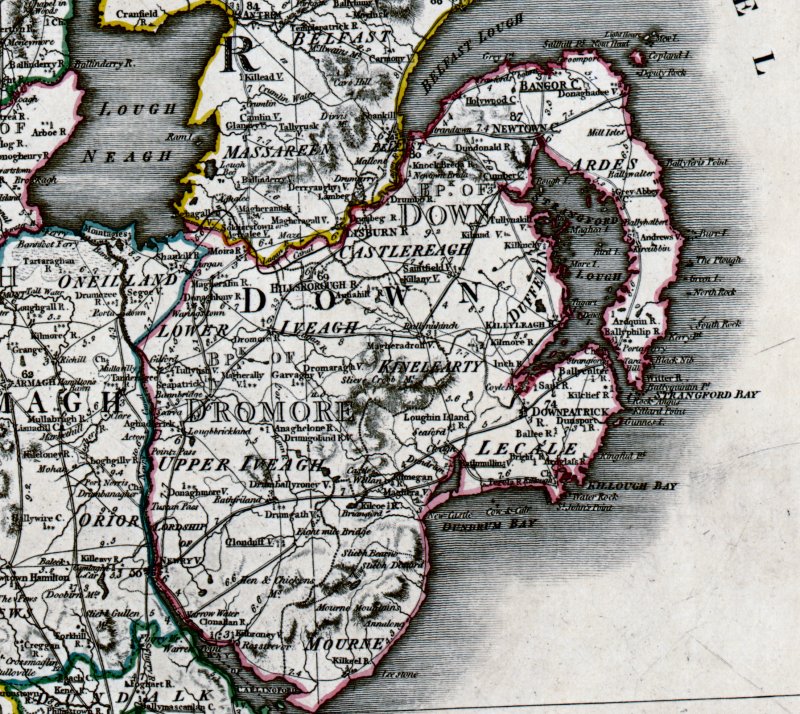
Vintage map of County Down in Northern Ireland; courtesy Library of Congress.
On July 25, 1761, in His Majesty's Colonies in America, the General Assembly of the Colony of South Carolina passed a bill known as the "Bounty Act," which "was a broadening of earlier immigration laws, for the special benefit of…religious refugees." Its purpose was to encourage the immigration of poor Protestant Europeans.2 Here is what historian R. J. Dickson has written about it:
By 1760, Indian attacks were causing 'distress and consternation' in South Carolina and, in order to increase the number of the white inhabitants of the colony, a duty was levied on the importation of negroes and the proceeds used to pay the passage money of protestant immigrants from Europe and to give forty shillings to each immigrant to purchase tools and provisions,. Immigrants were to be exempt from taxes for ten years and the head of every family was to be granted one hundred acres of land, together with fifty acres for each member of his family.3
Around this same time life was reportedly hard for the ordinary people of Northern Ireland. High rents, combined with periodic food shortages, had the effect of driving many young families to seek new opportunities elsewhere. Increasingly, they looked westward across the Atlantic-to America-for the chance to improve their lives.
Dickson tells us further that during the 1760s no fewer than "one hundred and ninety-four vessels were advertised to leave north Irish ports with emigrants to America…the peak years being…1766 and 1767."4 One of these ships, carrying an average of 146 passengers, was the Lord Dungannon, a brig that sailed from Belfast in late 1767. It was one of nine vessels that departed from ports in Northern Ireland that year, which were bound for Charleston, South Carolina.5
On board the Lord Dungannon were no less than one hundred and thirty-nine people (mostly young families), including thirty-two-year-old Hamilton Murdock-a weaver by trade, his thirty-year-old wife Mary, and the couple's six children: twelve-year-old Margaret, ten-year-old Elizabeth, eight-year-old William, five-year-old Jane, and the babies, Mary and James.6
We know nothing about our ancestors' journey across the Atlantic but we may imagine, based on accounts of other sea voyages of this time, that the four-to-eight-week sea voyage was tiresome, potentially dangerous, and uncomfortable. Nevertheless, in February 1768 the Lord Dungannon arrived safely at the port of Charleston and many of its passengers, upon producing "Certificates of their being members of Protestant Congregations & of their good behaviour," petitioned the Governor of the Colony of South Carolina for payment of "several Bounties allowed by [the Act of July 25, 1761]." Among these "poor Protestants…lately arrived here from Ireland,"7 of course, were Hamilton Murdock, his wife, and their children.
A print of the port of Charleston, which appeared in a London magazine in 1776, reveals the city as our Irish ancestors must have seen it as they entered the harbor on what was undoubtedly a cold winter day, even in South Carolina's more moderated clime. Then, as now, the city was low lying, with very few buildings that reached above two stories. Only the tall white steeple of the relatively new St. Michael's Episcopal Church (built between 1752 and 1761) stood out above the rooftops, serving as a navigational landmark for mariners.
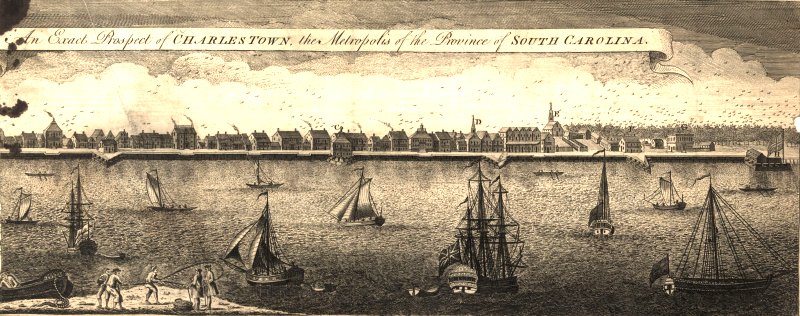
Vintage view of Charles Town, South Carolina; courtesy Library of Congress.
One of the benefits the immigrants received was payment of their passage across the ocean, which was in this case paid directly to "Messrs Torrens and Pouag in behalf of the owners of [the Lord Dungannon]." The amount was either £4 or £2, "according to their respective ages" Another benefit of the Act of 1761 was the payment of "twenty shillings sterling to [the immigrants] themselves." In addition, the head of each family was granted fifty acres of land for each member of his family that had accompanied him on the voyage. Including himself, Hamilton Murdock's family consisted of eight persons. However, for some unknown reason, he received only 350 acres instead of the 400 to which it appears he would have been entitled.8 One possible explanation is that the land grants were only applicable to family members above a certain age. Perhaps James Murdock, being less than two years old at the time, did not qualify.
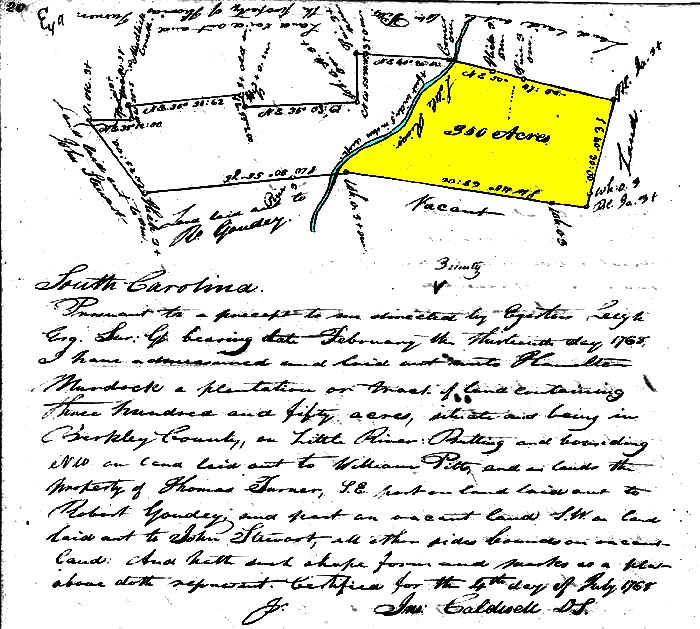
Hamilton Murdock's 1768 South Carolina Land Grant, alongside Little River.
Hamilton Murdock's original land grant was located in old Berkeley County. A year later, the province's districts were reorganized and the Murdock family found themselves living in the newly-established "Ninety-six" District, located in the western part of the colony.
In the fall of 1776 or 1777, while living in the Ninety-Six District, seventeen or eighteen-year-old William Murdock, substituting for his father Hamilton, enlisted for service as a private in a regiment of South Carolina militia led by Col. James Williams. Serving as a horseman in a company commanded by Captain Robert Gillam, young Murdock "was sent to Kellott's Station on Reedy River to keep the Indians in check." After being discharged, "he was drafted during June 1780 under the same officers" for another three-month term. He afterward "volunteered to serve under Lt. Christopher Hardy, a Captain Henderson and Colonel Williams as a horseman and sent against the Indians in Georgia."9
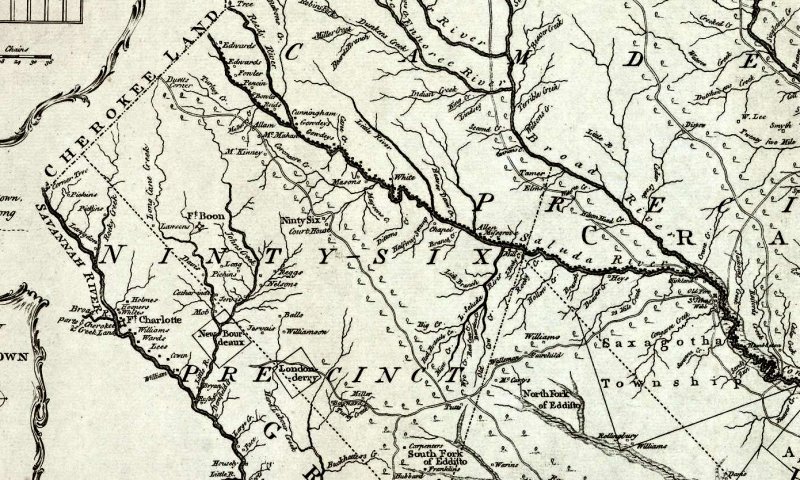
Vintage map of Ninety-Six District, in the "backcountry" of South Carolina, near Georgia; courtesy Library of Congress.
It appears that sometime before 1779, Hamilton Murdock's wife, Mary, died and that he afterward remarried. His second wife's name may have been Jean. It is likely that they had some children together but their names are unknown.10
In 1779, for the sum of £2,400 "current money," Hamilton Murdock (his name misspelled as Hambleton) purchased two tract of lands, one 250 acres, the other 89 acres, in Craven County, from one Thomas Clark, a Ninety-Six District planter, and his wife Mary. These were located on the Little River (a branch of the Saluda) and were bounded by "lands of Thomas Edgehill, Mattias Clark," originally granted to Thomas Clark in 1768 and 1772.Four years later, Hamilton Murdock, "planter," sold these same tracts to a blacksmith named Thomas Eakins for the sum of £600 "current money."11
On December 2, 1793, Governor Moultrie granted Hamilton Murdock 542 acres in Ninety-Six District, on Rocky Creek. This transaction was recorded in South Carolina Colonial Plat Book 32, p. 314.
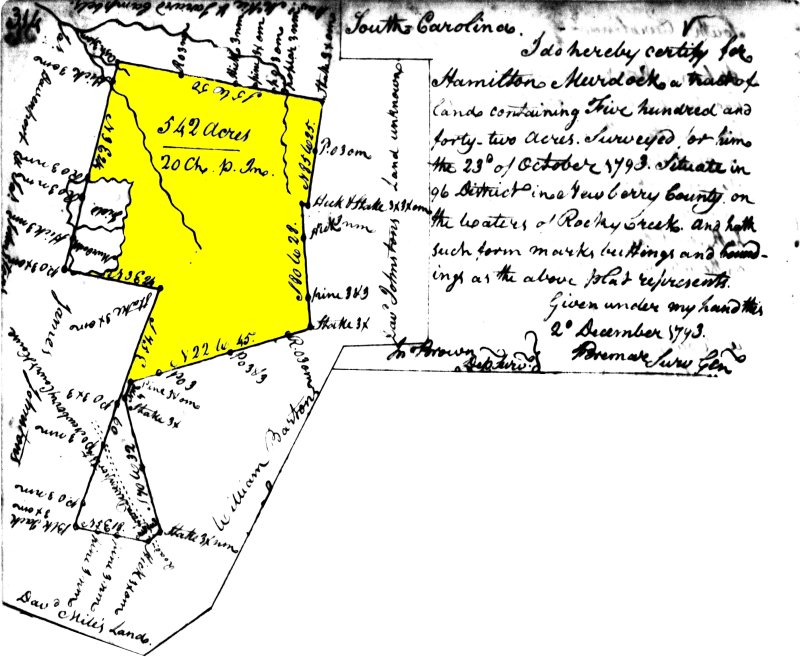
Hamilton Murdock's 1793 South Carolina Land Grant in Ninety-Six District, on Rocky Creek.
On September 9, 1799, Hamilton Murdock sold a 100 acre plantation in Newberry County to Levi Pitts for 80 Pounds Sterling. This transaction was recorded in Newberry County Deed Book D, pp.451-2.
Hamilton Murdock, for some unknown reason, was not enumerated in the 1790 federal census for South Carolina but in 1800, he is shown living in Newberry District, along with sons James and William, who were each listed separately with their own families. By this time, it appears that Hamilton Murdock's wife had died. There are no older females listed in his household, which consisted of himself and probably a widowed daughter and her two young sons, one under the age of ten, the other between ten and sixteen years of age. He owned one slave.
On April 4, 1800, Hamilton Murdock sold 74 acres of land to his son, James Murdock, for 32 Pounds Sterling. This transaction was recorded in Newberry County Deed Book G, pp. 341-2.
On January 25, 1803, Hamilton Murdock sold 198 acres of land (from 1793 grant) to his son, William Murdock, for $263. This transaction was recorded in Newberry County, South Carolina Deed Book F, pp. 95-6.
After Hamilton Murdock died intestate about 1805 in Newberry, South Carolina, his son William administered his estate, which consisted of livestock, household goods, and farming implements of no unusual value. We do not know where he was buried..
William Murdock
(1759 - ABT. 1840)
|
DISCLAIMER: Although to the best of my knowledge the information this section contains is correct, I am not completely sure that William Murdock is one of my ancestors. He could be, but in the absence of a corroborating "paper trail," his inclusion here should be considered tentative. |
William Murdock was born March 15, 1759 in Northern Ireland. He was a son of Hamilton and Mary Murdock.
In 1767, when he was eight years old, William's family immigrated to South Carolina from Ulster aboard the brig Lord Dungannon. Shortly after arrival, his father received a land grant of 350 acres in Berkeley County and twenty shillings for each member of the family.
In the fall of 1776 or 1777, while living in Ninety-six District, Newberry County, seventeen or eighteen-year-old William Murdock, substituting for his father Hamilton, enlisted for service as a private in a regiment of South Carolina militia led by Col. James Williams. Serving as a horseman in a company commanded by Captain Robert Gillam, young Murdock "was sent to Kellott's Station on Reedy River to keep the Indians in check." After being discharged, "he was drafted during June 1780 under the same officers" for another three-month term. He afterward "volunteered to serve under Lt. Christopher Hardy, a Captain Henderson and Colonel Williams as a horseman and sent against the Indians in Georgia."12
William Murdock was married about 1780 to Mary Mills, probably in Berkeley County, South Carolina. Together they had the following named children:
- Ann Murdock, born 178 1
- David Murdock, born 1784
- John Murdock
- James Murdock
- POSSIBLY, NOT PROVEN: Elliott H. Murdock, born about 1790
- Thomas H. Murdock, born before 1797
There is a William Murdock enumerated in the 1790 federal census for South Carolina, living in Salisbury District. However, we cannot be sure if this man was our ancestor.13
In 1800, the family of "our" William Murdock was found living in Newberry District, South Carolina, along with the families of his brother James Murdock and his father Hamilton Murdock. William Murdock was also included in the 1810 and 1820 federal census for Newberry District.14
Although it appears that there is no record of William Murdock in the 1830 census, it was probably around this time that he went to live with the family of his son Thomas H. Murdock in Franklin County, Georgia. There, on September 3, 1832, William Murdock applied for and was granted a pension based on his service in the Revolutionary War.15 It appears that he also lived for a period of time in Elbert County, Georgia and that he died about 1840 in Franklin County-but after the census was taken, in which he is listed as an 80 to 90 year old male residing in the household of Thomas Murdock. His 80 to 90 year old wife is also enumerated in this household.16 We do not know where either he or his wife are buried.
Elliott H. Murdock
(ABT. 1790 - AFT. 1850)
Elliott H. Murdock, who may have been a son of William and Mary (Mills) Murdock, was born about 1790, possibly in South Carolina, although the 1850 federal census says Georgia. Although no documentary evidence of a link to the family of William and Mary Mills Murdock has so far been found by this author, the fact that Elliott Murdock's middle initial was "H," which could have stood for "Hamilton" makes it possible (but unproven) that Elliott H. Murdock was a child of William and Mary Mills Murdock.
It's been speculated by another researcher (see The South Carolina Historical Magazine, Vol. 75, No. 2, April 1974, p. 133) that on December 6, 1821, in Greene County, Tennessee, Elliott Murdock married twenty-one-year-old Eliza or Elizabeth Shannon Magill, a daughter of Samuel and Maggie Magill. However, there is no record of this marriage in Greene County, Tennessee. Another source (South Carolina Magazine of Ancestral Research, Vol 3, No. 1, 1975) states that Elliott Murdock married Eliza Magill in South Carolina. All we can be certain of is that Elliott's wife's first name was Eliza (or possibly Elizabeth) and that by 1830 they were settled in Hamilton County, Tennessee (near Chattanooga), and then by 1840, had crossed the state line into Walker County, Georgia, which is immediately adjacent to Hamilton County, Tennessee.
Together, Elliott Murdock and his wife had the following twelve children:
- William H. (Hamilton?) Murdock, born September 26, 1822 (married Mary McCrary)
- Elizabeth B. Murdock, born August 30, 1824 (married Mark Lowry on September 17, 1845 in Walker County, Georgia, died January 30, 1862)
- Patsey Murdock, born February 10, 1827 (may have died in infancy)
- Tennessee (female) Murdock, born 1828
- John T. Murdock, born June 5, 1829
- Carroll Murdock, born January 15, 1832
- Mary A. Murdock, born June 14, 1832
- Daniel J. Murdock, born March 11, 1837
- Elliott Francis Murdock, born October 11, 1839
- Thomas J. L. Murdock, born October 26, 1842
- Martha Murdock, born December 21, 1845 (married Thomas Duncan in 1867)
- R. Murdock (male), born about 1856
Presumably, all these children were born in Walker County, Georgia, with the possible exception of the four older children, who were probably born in Tennessee.17
The 1830 federal census for Hamilton County, Tennessee conforms to expectations, except for there being only one female under the age of five, instead of two, and the inclusion of an older couple, a male age 60 to 69 and a female, age 50 to 59. So far, this author has been unable to ascertain the identity of this older couple.
The 1840 federal census for Walker County, Georgia almost conforms to expectations. There are two males under age 5 (Daniel and Elliott F.), one male age 5 to 9 (Carroll), and two males age 10 to 14 (John T. and who?). There ought to be only one male age 10 to 14 and one male 15 to 19 (William H.). It's possible, however, that the census-taker simply made a mistake, because otherwise, the number of young males in the household is correct. The elder Elliott is shown as being from 50 to 59. There is also one female under the age of 5 that can't be accounted for. This could be an infant that died sometime before 1850. The remaining females conform to expectations. There are two between the ages of ten and fourteen (Patsy and Tennessee), one between 15 and 19 (Elizabeth), and one from 30 to 39 (Elliott's wife, Eliza).
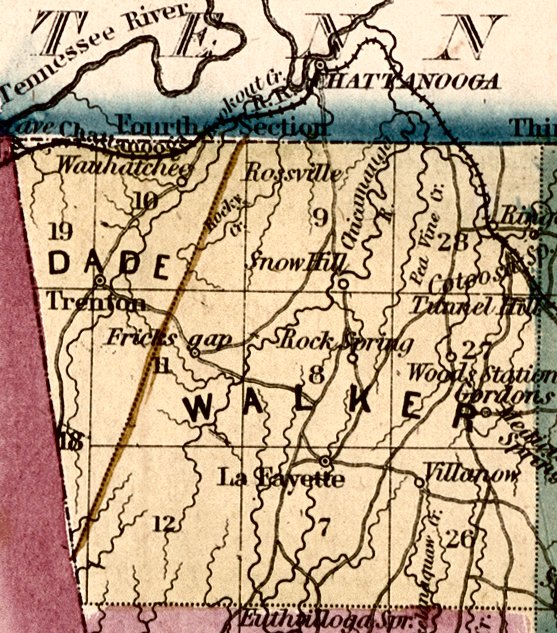
Vintage map of Walker County, Georgia, showing some of the places (Snow Hill and Frick's Gap, where they are known to have lied; courtesy Library of Congress.
The 1850 federal census for this family, also in Walker County (West Chickamauga), Georgia, lists Elliott (misspelled Ellet), age 60, Eliza, age 50, Tennessee, age 21, Mary, age 16, Daniel, age 13, [Elliott] Francis, age 11, Thomas, age 8, and Martha, age 6.
The 1860 Walker County, Georgia federal census for this family (Post Office: Snow Hill) lists "E." (female), age 55, as head of the household, which tells us that she was a widow. Other members of the household at this time include "F" (Francis), age 20, farm laborer, "M" (Martha), age 14, and "R" (?), male, age 4, which tells us that his father, Elliott, was still alive in 1855 or 1856. Thomas, age 18, ought to be listed too, but isn't. Elliott and Eliza's son, William H. Murdock, age 37 and a miller by occupation, along with his wife and four young children, are listed immediately above.
Apart from the federal census, there seems to be no other available records pertaining to Elliott H. Murdock. It appears that he died sometime between 1855 and 1860, and was buried, most likely, somewhere in Walker County, Georgia.
Eliza Murdock was still living when the 1870 federal census for Walker County, Georgia was taken. At that time, she was living near Frick's Gap with her daughter, Martha, who had married Thomas Duncan in 1867, and Martha's 11-month-old daughter, Mary. The absence of Thomas Duncan suggests that Martha was a young widow. The absence of "R," who was named in the previous census suggest that he was either dead or living elsewhere.
The absence of Eliza Murdock from the 1880 federal census suggests that she died sometime between 1870 and 1880. In all likelihood, she too was buried somewhere in Walker County, Georgia. Unfortunately, there is no apparent record of which cemetery in which she or her husband were laid to rest.
WHY IT'S HARD TO RESEARCH THIS FAMILY
In early February 1883, a fire, allegedly set by an arsonist, burned down the Walker County courthouse in Lafayette, Georgia, destroying all county records that might have shed some light on this and every other family that lived in Walker County prior to the fire. Here is a newspaper article about it that appeared in the February 3, 1883 issue of The Atlanta Constitution:

ENDNOTES
- I obtained most of this information from undocumented pedigree charts on both the Familysearch and Ancestry.com websites.
- Janie Revill, compiler, A Compilation of the Original Lists of Protestant Immigrants to South Carolina, 1763-1773 (Baltimore: Genealogical Publishing Company, 1974), 3.
- R. J. Dickson, Ulster Emigration to Colonial America, 1718-1775 (London: Routledge and Kegan Paul, 1966), 56.
- Ibid., 55.
- Ibid., 57.
- Revill, A Compilation of the Original Lists of Protestant Immigrants to South Carolina, 1763-1773, 106; Janie Revill, Some South Carolina Genealogical Records (Easley, South Carolina: Southern Historical Press, 1986), 209.
- Revill, A Compilation of the Original Lists of Protestant Immigrants to South Carolina, 1763-1773, 7 & 103.
- Revill, A Compilation of the Original Lists of Protestant Immigrants to South Carolina, 1763-1773, 103-106.
- Moss, South Carolina Roster, 711.
- This guess is based on two pieces of circumstantial evidence. First, a 1783 land transaction that was signed by Hamilton, Murdock, John Murdock, and Jean Murdock. A John Murdock, possibly Hamilton Murdock's brother, came to South Carolina from Ulster in 1763 (see Nevill, A Compilation of the Original Lists of Protestant Immigrants to South Carolina, 1763-1773, 8). There is no other way to account for Jean Murdock, unless she was John's wife. There is also the 1800 federal census of Newberry District, South Carolina to consider. It shows Hamilton Murdock with only one female in the household and she is aged 16 to 26 years, with two young sons. It seems unlikely that this person was his wife but she may have been a daughter by a second marriage, born in South Carolina between 1774 and 1784.
- Revill, Some South Carolina Genealogical Records, 209. I have a feeling the amount shown in this book is a typographical error. It should probably read £240.
- Moss, South Carolina Roster, 711.
- 1790 federal census for South Carolina.
- 1800, 1810, and 1820 federal census for Newberry District, South Carolina.
- Revolutionary War service pension for William Murdock, on file in the National Archives, Washington, D.C. File no. S31873. See Virgil White's Abstracts of Revolutionary War Service Pensions, 2456.
- 1840 Federal Census for Franklin County, Georgia.
- I got this list from my aunt, Inez Jenkins Hickman, who got it in turn from another relative whose name I do not know. It is corroborated, more or less, by the 1850 and 1860 federal census for Walker County, Georgia.
This website copyright © 1996 - 2024 by Steven Butler. All rights reserved.

